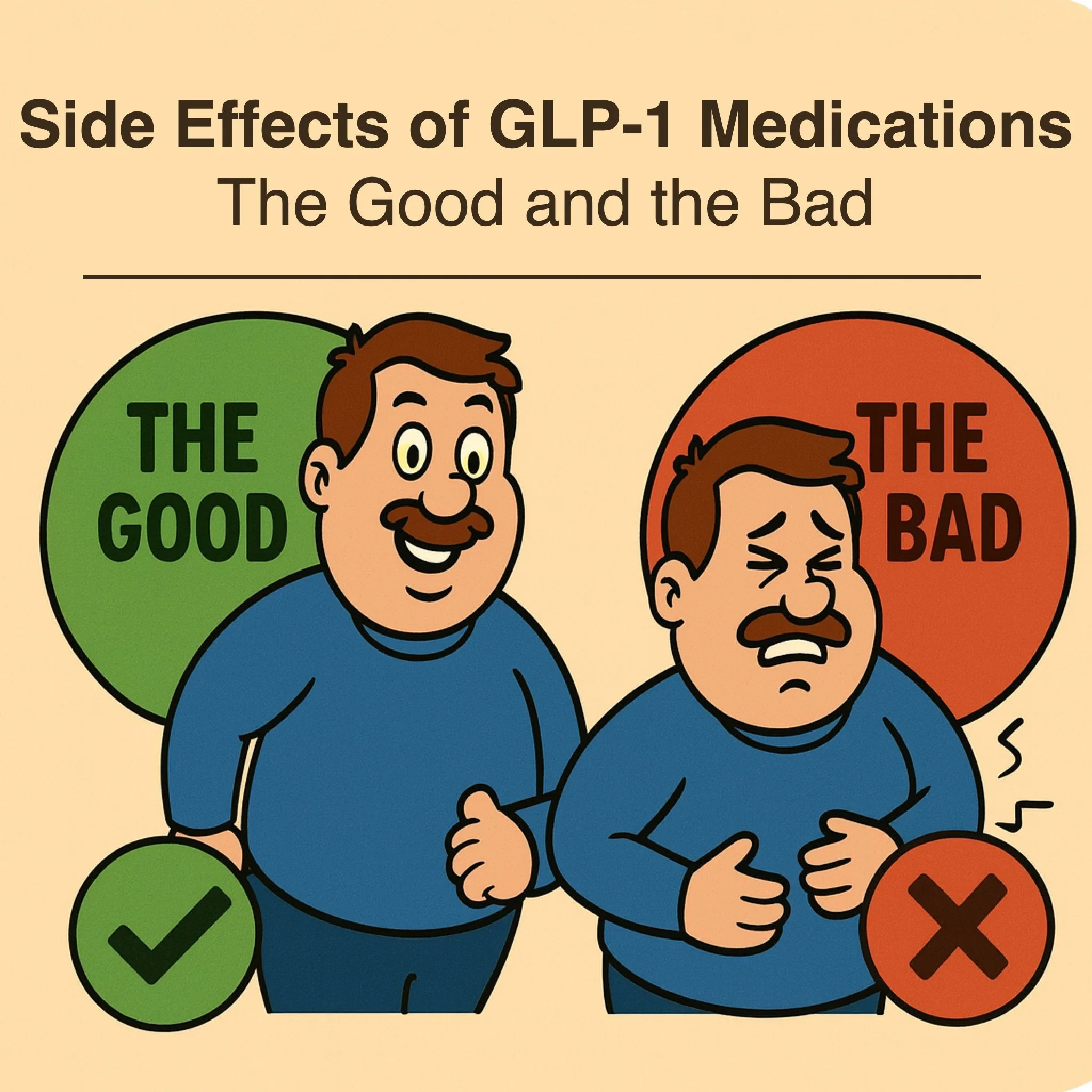Side Effects of GLP-1’s - The Good and the Bad
Side Effects of GLP-1 Medications – The Good and the Bad
GLP-1 (glucagon-like peptide-1) medications such as semaglutide (Ozempic®, Wegovy®) and tirzepatide (Mounjaro®, Zepbound®) have completely changed how we approach weight loss and metabolic health. They’re powerful, effective, and — when used correctly — life-changing.
But like every medication, GLP-1s come with both benefits and side effects. Some are welcome (the “good”), while others require monitoring and management (the “bad”).
🟢 The “Good” Side Effects
1. Reduced Appetite and Food Noise
Most patients notice that food cravings fade dramatically. GLP-1s act on appetite centers in the brain, making it easier to eat smaller portions and stop obsessing about food.
2. Weight Loss and Fat Reduction
Average weight loss ranges from 10%–20% of total body weight over several months. This reduction comes primarily from fat mass—not muscle—which is critical for long-term metabolic improvement.
3. Better Blood Sugar and Insulin Sensitivity
GLP-1s help stabilize glucose levels and reduce insulin resistance. Many patients see their A1C drop into the normal range, even those with pre-diabetes or type 2 diabetes.
4. Cardiovascular Benefits
Large clinical trials show that GLP-1s can reduce the risk of major cardiovascular events, such as heart attacks and strokes. These drugs are now considered part of heart-protective therapy in certain high-risk patients.
5. Reduced Inflammation and Liver Fat
Emerging evidence suggests GLP-1s may improve fatty liver disease (NAFLD) and systemic inflammation, contributing to overall metabolic “reset.”
6. Reduced cravings for alcohol and addictive substances in some studies.
Many clients report significant decreases in alcohol consumption and GLP-1s are being studied for nicotine and opioid abuse disorders.
7. And so many others…
Here is partial list of other possible to probable positive benefits that have yet to be proven:
Obstructive Sleep Apnea
Dementia
Lower blood pressure (average 2–6 mmHg reduction).
Improved lipid profile — lower triglycerides, modest rise in HDL (“good” cholesterol).
Anti-inflammatory and endothelial-protective effects, improving vascular health.
Better emotional control and less “reward eating” due to central appetite regulation.
Possible neuroprotective benefits — early data suggest lower risk of cognitive decline and Alzheimer’s disease.
Lower liver fat and improved markers of non-alcoholic fatty liver disease (NAFLD).
Improved mobility and joint pain relief secondary to weight loss.
Enhanced energy levels and quality of life reported in patient surveys.
Reduced risk of progression from prediabetes to diabetes.
Potential longevity benefits due to improved metabolic and inflammatory markers.
🔴 The “Bad” Side Effects
1. Nausea, Bloating, and Reflux
Gastrointestinal symptoms are the most common. Because GLP-1s slow stomach emptying, early satiety can turn into discomfort if meals are too large or eaten too quickly. The good news: symptoms usually improve as the body adjusts.
2. Constipation
Decreased GI motility often leads to constipation. Staying hydrated, increasing fiber intake, and mild stool softeners usually help. We strongly recommend Miralax for constipation.
3. Fatigue or Dizziness
Some patients experience fatigue during dose escalation. This is often related to lower calorie intake or dehydration rather than the medication itself.
4. Gallbladder Issues
Rapid weight loss (from any cause) increases the risk of gallstones. Staying hydrated and avoiding extremely low-fat diets can help minimize this risk.
5. Muscle Loss if Calories Are Too Low
When calories drop too quickly, the body can lose lean muscle mass. That’s why I emphasize protein intake and resistance exercise during GLP-1 therapy.
6. Rare Pancreatitis or Intestinal Obstruction
True pancreatitis is rare but serious. Patients with a history of pancreatitis should use caution. Very rarely, delayed gastric emptying can contribute to bowel issues, though the evidence is still evolving.
The Takeaway
The benefits of GLP-1 therapy usually far outweigh the risks, especially when prescribed and monitored by an experienced clinician. Nearly all side effects are manageable with proper guidance on dosing, hydration, and nutrition.
GLP-1s are not a “miracle shot,” but they can be a powerful medical tool for lasting weight loss, improved health, and better quality of life—when used correctly and responsibly.

